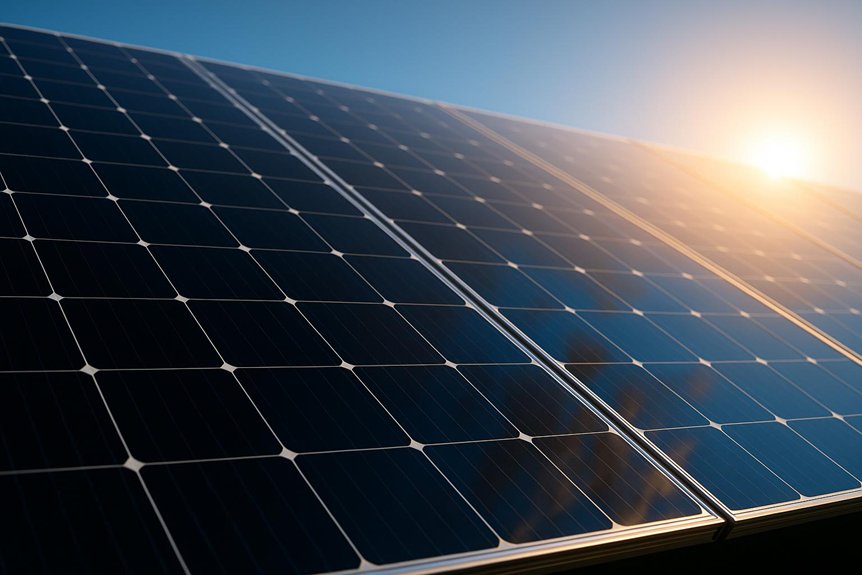Monocrystalline solar panels, made from single-crystal silicon, offer the highest efficiency rates—typically 20% to 25%—enabling maximum energy output in limited spaces. They provide a sleek black design and a long lifespan of 30 to 40 years, but their complex manufacturing results in higher costs, often $1,000 to $1,500 per kilowatt installed. While sensitive to shading, they suit residential, commercial, and remote settings well. Exploring further reveals detailed advantages, production methods, and cost considerations.
What Are Monocrystalline Solar Panels?
Monocrystalline solar panels consist of single-crystal silicon, which enhances electron movement and results in efficiency ratings typically between 20% and 25%. This improved electron flow allows these panels to convert sunlight into electricity more effectively than other types. You’ll notice their sleek black appearance, which often makes them a preferred choice for residential and commercial installations focused on aesthetics. Additionally, monocrystalline panels deliver higher power output per square foot, making them particularly suitable when roof space is limited. Their durability is notable, with a lifespan of 30 to 40 years and warranties frequently extending up to 25 years, ensuring a long-term investment. As of 2024, these panels dominate the solar market, accounting for roughly 98% of solar cell production, underscoring their widespread adoption and proven performance. Furthermore, their lower degradation rate over time contributes to consistent energy production and reliability.
How Monocrystalline Solar Panels Are Manufactured
The manufacturing of these solar panels begins with the extraction of highly pure silicon, which is melted down and shaped into single crystal ingots through the Czochralski process. You then slice these ingots into thin wafers, usually less than 0.5 millimeters thick, creating individual solar cells. Each wafer undergoes chemical etching and diffusion processes that prepare the surface to optimize electrical properties. An antireflection coating is applied next to enhance light absorption, essential for efficiency. Conductive metal contacts, typically made of silver, are printed onto the wafers to collect the electric current generated when sunlight excites the silicon. Finally, you encase the completed solar cells in protective materials like glass or plastic, adding a backsheet and frame to guarantee durability and maintain performance over time.
Advantages and Disadvantages of Monocrystalline Solar Panels
Understanding the manufacturing process provides a foundation for evaluating the strengths and limitations of these solar panels. Monocrystalline panels boast high efficiency ratings, typically between 20% and 25%, making them the most efficient solar technology available. Their space efficiency means you need fewer panels to generate equivalent power compared to polycrystalline options. Additionally, these panels offer a longer lifespan, often lasting 30 to 40 years, with warranties extending up to 25 years. However, the complex manufacturing process results in higher costs, ranging from $1,000 to $1,500 per kW, which might impact your budget. You should also consider their sensitivity to shading, as partial shading can greatly reduce performance. Balancing these advantages and disadvantages is essential when deciding if monocrystalline panels meet your energy needs.
Applications and Ideal Use Cases for Monocrystalline Panels
Because of their high efficiency and compact design, these solar panels suit residential rooftops where space is limited, delivering power outputs typically between 20% and 25%. You’ll find them ideal for commercial buildings aiming to maximize energy generation within confined areas, enhancing return on investment. Utility-scale solar farms also favor monocrystalline panels, as their superior efficiency allows for greater energy production on smaller plots of land compared to other panel types. If you need off-grid power for remote cabins or rural homes, these panels provide the efficiency and reliability necessary for energy independence. Additionally, their sleek black appearance makes them a preferred choice for installations emphasizing aesthetic integration, allowing you to maintain architectural appeal while optimizing solar performance.
Cost Factors and Financial Incentives for Monocrystalline Solar Systems
Although monocrystalline solar panels often come with a higher upfront cost compared to other types, their installation expenses typically range from $1,000 to $1,500 per kilowatt, leading to total system costs between $6,000 and $8,000 without including battery storage. For instance, a 4.5kWp system with about 10 panels can cost around £10,300 in the UK, with prices varying by panel size and installation complexity. Financial incentives such as the Smart Export Guarantee (SEG) offer payments for electricity you export, while schemes like ECO4 and the Home Upgrade Grant provide funding for energy improvements, especially to low-income households. Additionally, participating in the SEG can help reduce carbon emissions and enhance energy savings over time. Despite the initial expense, monocrystalline panels can increase your property value and enhance energy independence, making them a financially sound long-term investment.
